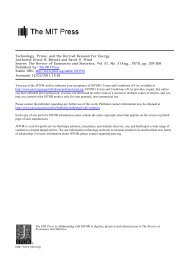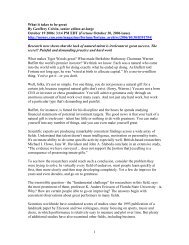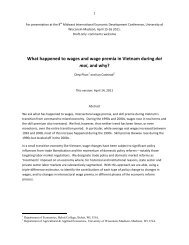Capital-Labor Substitution and Economic Efficiency Author(s): K. J. ...
Capital-Labor Substitution and Economic Efficiency Author(s): K. J. ...
Capital-Labor Substitution and Economic Efficiency Author(s): K. J. ...
You also want an ePaper? Increase the reach of your titles
YUMPU automatically turns print PDFs into web optimized ePapers that Google loves.
CAPITAL-LABOR SUBSTITUTION AND ECONOMIC EFFICIENCY 247<br />
have proposed instead the hypothesis that //a<br />
is constant across countries, while differences<br />
in efficiency are neutral. But we have also found<br />
some slight indications, in comparing Japan <strong>and</strong><br />
the United States, that the American advantage<br />
in efficiency tends to be least in capital-intensive<br />
industries. This pattern, if it were verified,<br />
would seem to lead to an alternative interpreta-<br />
tion of the Leontief phenomenon. But it also<br />
opens wide the question of why this association<br />
between differential efficiency <strong>and</strong> capital in-<br />
tensity should occur. Some possible explana-<br />
tions were mentioned in section IV-C, but the<br />
reader can think of others. We may be missing<br />
something important by excluding third factors,<br />
or external effects, or the importance of gross<br />
investment itself as a carrier of advanced tech-<br />
nology into a sector.<br />
Another active area of economic research<br />
where our results may have some interest is the<br />
theory of economic growth. An as yet unpub-<br />
lished paper 31 by J. D. Pitchford of Melbourne<br />
University considers the introduction of a CES<br />
production function into a macroeconomic mod-<br />
el of economic growth <strong>and</strong> concludes that at<br />
least in some cases this amendment restores to<br />
the saving rate some influence on the ultimate<br />
rate of growth. Even more interesting are the<br />
possible implications for disaggregated general<br />
equilibrium models. Given systematic inter-<br />
sectoral differences in the elasticity of substitu-<br />
tion <strong>and</strong> in income elasticities of dem<strong>and</strong>, the<br />
possibility arises that the process of economic<br />
development itself might shift the over-all elas-<br />
ticity of substitution.<br />
C. Unsettled Questions<br />
Our general reference under this heading is<br />
passim. To begin with, as usable capital data<br />
for more countries <strong>and</strong> more industries become<br />
available, all of our results become subject to<br />
check for validity <strong>and</strong> generality. In particu-<br />
lar, our speculations about the causes of vary-<br />
ing efficiency are based primarily on compari-<br />
sons between Japan <strong>and</strong> the United States. A<br />
more extensive study might easily controvert<br />
them.<br />
Another loose end has to do with the question<br />
"1Now published: "Growth <strong>and</strong> the Elasticity of Factor<br />
<strong>Substitution</strong>," <strong>Economic</strong> Record, December I960, 49I-500.<br />
(Note added in proof.)<br />
of returns to scale. We note that the stringent<br />
test for constant returns to scale <strong>and</strong> constancy<br />
of all parameters clearly has to be rejected. But<br />
it would be useful to explore the possibility of<br />
increasing returns to scale on a broader front.<br />
In view of equation (I6) is there some choice<br />
of the function C(K) which would yield a test<br />
on increasing returns? What light might this<br />
throw on the international comparisons, espe-<br />
cially in connection with the less developed<br />
economies?<br />
Finally, the whole question of further dis-<br />
aggregation calls out for exploration. We have<br />
in mind here not so much a finer industrial<br />
breakdown as a finer input breakdown. Can<br />
our labor <strong>and</strong> capital inputs be usefully sub-<br />
divided? How about natural resource <strong>and</strong> pur-<br />
chased material inputs?<br />
References<br />
i. M. Abramovitz, "Resource <strong>and</strong> Output Trends in<br />
the United States Since I870," American Econom-<br />
ic Review, XLVI (May I956), 5-23.<br />
2. R. G. D. Allen, Mathematical Analysis for Econo-<br />
mists (London, I938).<br />
3. K. J. Arrow, "Toward a Theory of Price Adjust-<br />
ment," in M. Abramovitz et al., The Allocation of<br />
<strong>Economic</strong> Resources (Stanford, California, I959),<br />
4I-5I.<br />
4. G. W. Bickel, "Factor Proportions <strong>and</strong> Relative<br />
Prices in Japan <strong>and</strong> the United States," paper read<br />
to the summer meeting of Econometric Society<br />
(Stanford, California, August 1960).<br />
5. H. B. Chenery, "Patterns of Industrial Growth,"<br />
American <strong>Economic</strong> Review, L (September I960),<br />
624-54.<br />
6. H. B. Chenery, S. Shishido, <strong>and</strong> T. Watanabe, "The<br />
Pattern of Japanese Growth, I9I4-54," June 1960<br />
(mimeog.)<br />
7. G. H. Hardy, J. E. Littlewood, <strong>and</strong> G. P6lya, In-<br />
equalities (Cambridge, Engl<strong>and</strong>, I934).<br />
8. L. Johansen, "Rules of Thumb for the Expansion<br />
of Industries in a Process of <strong>Economic</strong> Growth,"<br />
Econometrica, xxviii (I960), 258-7I.<br />
9. I. B. Kravis, "Relative Income Shares in Fact <strong>and</strong><br />
Theory," American <strong>Economic</strong> Review, XLIX (I959),<br />
Io.<br />
9 I 7-49.<br />
W. W. Leontief, "Domestic Production <strong>and</strong> Foregn<br />
Trade: The American <strong>Capital</strong> Position Reexamined,"<br />
Proceedings of the American Philosophical<br />
Society. 97 (953), 33 I-49.<br />
i i. W. A. Lewis, "<strong>Economic</strong> Development with Unlimited<br />
Supplies of <strong>Labor</strong>," The Manchester School,<br />
XXII (1954), I39-9I.<br />
I 2. B. S. Minhas, "An International Comparison of<br />
the Rates of Return on <strong>Capital</strong> in Manufacturing







